Recent Posts
Fixing Your Leaky Toilet
8/16/2022 (Permalink)
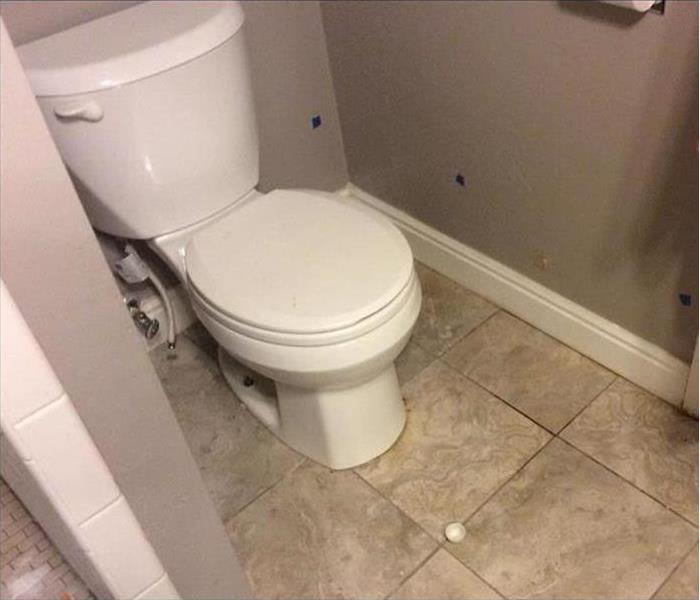 A leaking toilet in Ogden, UT.
A leaking toilet in Ogden, UT.
Suddenly discovering a puddle of water in the bathroom can be concerning. In most cases, the cause of a bathroom leak is the toilet. While a leaking toilet is a problem you’ll want to address as quickly as possible, it isn’t as daunting as it might seem. Here are steps you can take to stop the leak and minimize the impact of water damage to your home.
4 Steps to Stop a Toilet Leak
1. Find the Leak
The first visible indication that your toilet has a leak is the presence of water on your bathroom floor. However, sometimes, you won’t see any water at all. That’s because leaking water can get trapped between your flooring and underlayment. If you suspect a leak, probe the floor for spots that feel soft or spongy. If the toilet is on an upper floor, water can leak down the flange and stain the ceiling below. You can’t miss the unmistakable odor of sewer gas when a toilet isn’t seated properly.
2. Tighten the Bolts
Once you’ve determined the toilet is the culprit, inspect its fit. Is it stable, or does it rock? If the anchor bolts on either side are loose, tighten them down. Alternate when tightening to ensure you don’t overdo it. Too tight, and you could break the flange.
3. Replace the Wax Ring
If the leak persists after tightening the bolts, you’ll have to replace the wax ring that sits between the toilet and the flange. Over time, this ring can dry out and break the seal, resulting in a leaking toilet. You’ll need to uninstall the unit, remove the old ring and install a replacement.
4. Beware of Hidden Damage
Hopefully, you’ve caught the leak early enough. If the toilet leak has exposed your subfloor and structural supports to water, however, there may be larger issues you need to consider. If there’s any question whether the leak has caused rot or damage, contact a restoration specialist in Ogden, Utah, who can assess the situation and suggest the proper repairs.
If you find you have a leaking toilet, address the issue as quickly as possible. If necessary, call in a professional for expert help.
What To Do if a Flood or Toilet Overflow Causes a Category 3 Water Loss
7/30/2022 (Permalink)
 Category 3 water damage in local commercial building.
Category 3 water damage in local commercial building.
Some causes of water damage, such as a pipe break, are relatively safe. The liquid that comes from main lines is fairly clean. However, other water losses, such as a toilet overflow, can cause dirty, unsanitary fluid to enter your business. These are considered Category 3 water losses, and they require the assistance of experienced remediation professionals in Ogden, UT.
Category 3 Damage Comes From Flood Water or Sewage
There are three primary types of water damage. Category 1 damage results from sanitary water sources. If you accidentally inhale, touch or ingest this water, you will not be at risk of substantial harm. Common sources of Category 1 damage include:
- Broken pipes
- Overflowing sinks
- Melting snow and ice
- Malfunctioning drinking fountains
Meanwhile, Category 2 losses occur when water with potentially dangerous contaminants enters your property. The microorganisms in this gray water could be harmful to animals and people.
Water from a broken aquarium is considered Category 2. Hydrostatic pressure seepage from a basement falls into this category, as well. A toilet overflow may also qualify as Category 2 if the toilet only contains urine.
Category 3 Water Losses Are the Most Severe.
Category 3 water is highly contaminated, and any items that contact this water must be removed and dried immediately. Flood water following a rainstorm or hurricane is usually Category 3. That is because it often mixes with sewage or river water before entering your property. Toilet water that contains feces is considered Category 3, as well. If not properly addressed, Category 1 or 2 damage could end up Category 3 over time.
Why Category 3 Damage Spreads Quickly
Once the water comes into your building, the contaminants feed off the flooring and walls. This quickly increases the harm to the property. The water may also seep deep into your carpet, furniture and other assets. If your premises is warm or humid, mold and other fungi could spread even more swiftly.
How To Address Category 3 Damage
Just touching Category 3 water could be dangerous. This type of water damage also must be addressed right away. Local remediation professionals should know how to handle the situation. You should thus contact them as soon as it is safe to do so.
As you wait, do not turn on any electronic devices that have contacted the water. You may want to shut off the electricity until the property is dry.
Once the experts arrive, they should extract the water from the premises and remove any affected items so they can be dried. Dehumidifiers and other similar equipment can eliminate additional water that may not be readily visible.
The pros should then utilize a variety of cleaning techniques to restore your valuable assets. They can use specialized equipment to sanitize everything, as well. Antibacterial and antimicrobial treatments should eliminate the contaminants from your property. Meanwhile, industrial air scrubbers can remove the foul odors the contaminants left behind.
Category 3 water damage is the most severe. It typically occurs when sewage or flood water seeps into your home. Because Category 3 water is so dangerous, it should only be handled by remediation professionals.
First Aid Tips for Employee Burns
7/25/2022 (Permalink)
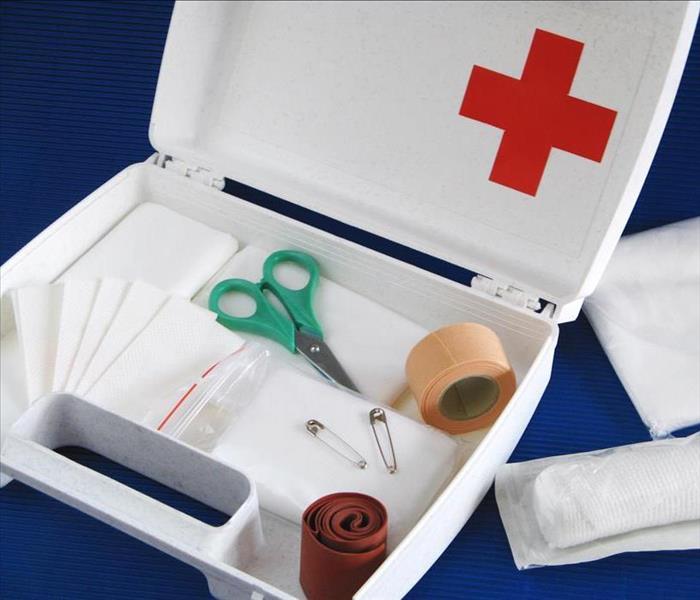 First aid kit
First aid kit
Burn risks for employees are highest in workplaces where people work with high heat, open flames or chemicals. However, even office environments carry some burn risks. While it is important to have a plan to deal with fire damage to your property, you also need to know how to deal with burn injuries to employees.
Burn First Aid Tips
Chemicals, hot liquids, hot food, the sun, flames, steam and electricity can all cause burn injuries. Major burns require emergency medical treatment. However, minor burns may be treated with first aid.
Know When To Seek Emergency Care
Contact 911 or take your employee to the nearest emergency room if there are signs of a serious burn:
- Burn is deep and affects all layers of the skin
- Skin has a charred appearance or there are patches of brown, white or black
- Burns cover the feet, hands, groin, face, buttocks, a major joint or encircle an arm or a leg
- Injury swells quickly
- Skin appears leathery and dry
- Burn is larger than three inches in diameter
You should also seek immediate medical attention for anyone who has a smoke inhalation injury because of fire damage. Electrical and chemical burns require emergency care. Minor burns may also need immediate care if they are on a person's mouth, eyes, hands or genitals.
Cool the Burn
For a minor burn, place the burned area under cool running water for 10 minutes. If the burn is on a part of the body that you can not place under running water, use a cool, wet cloth to ease the pain. A piece of ice can be placed in the mouth to relieve the pain of a mouth burn from hot food or drink.
Do Not Break Blisters
Blisters help prevent infections. Do not intentionally break them. If a blister breaks open on its own, gently clean the area with water and then put an antibiotic ointment on the area.
Bandage the Injury
Protect damaged skin by covering it loosely with a clean bandage. This will keep air off the injury and reduce pain.
Remove Rings and Tight Clothing
Burn injuries may swell. Gently remove rings or tight clothing from the burned area.
Use Lotion
After cooling the burn with water, applying lotion can keep the skin from drying and provide some pain relief. Avoid lotion with alcohol or other irritating ingredients.
Provide an Over-the-Counter Pain Reliever
If the person is in pain, provide them with an OTC pain reliever, such as ibuprofen, acetaminophen or naproxen. If the person is in severe pain, medical treatment may be necessary.
Clean Damaged Areas
Once any injured employees have been taken care of, contact a fire restoration service in Ogden, UT, to clean the area. Lingering smoke smells, ash, soot and chemicals could create a workplace hazard.
Burns from fire damage or other causes can be painful and frightening for employees. The steps you take after a burn injury can make a difference in how well your employee can recover from the injury. Follow these tips and seek emergency medical care whenever necessary.
4 Home Flood Water Preparations That Make Sense
7/20/2022 (Permalink)
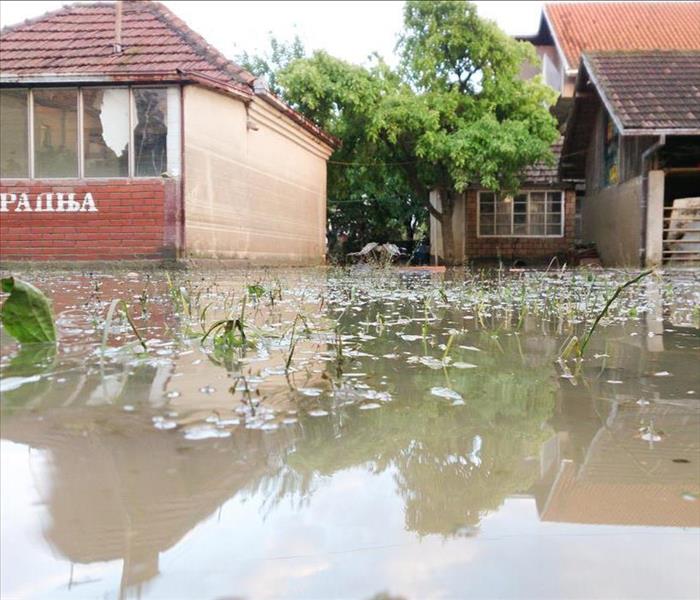 Flood waters can damage your home.
Flood waters can damage your home.
No matter where you live, storms have the potential to cause damage to your property. As recent heavy rains in Yellowstone National Park and other locations indicate, extreme storms have enormous power. One devastating consequence is when flood water becomes so high that it enters your home in Ogden, UT, and causes significant property damage. While many weather events are difficult to prevent, you can take some common-sense precautions that fortify your home against rains and floods.
4 Smart Ways To Minimize Damage From Flood Water
1. Discuss Your Options
Everyone in your household should know what to expect in a flooded building situation. A few timely actions could minimize property damage and increase the safety of loved ones and pets. Children should know about the safest locations to retreat to if water comes into the home, and they should have an understanding of calling for professional help if necessary. The family should also discuss the importance of avoiding electrical features of the home should wires or power boxes become saturated with water.
2. Make a Flood Water Plan
A home plan should go over the evacuation route should a major storm impact your community. Several agencies can help you with this, including the Department of Homeland Security and FEMA, as well as other online resources. Your home should have a solid first aid kit that is kept in a high area of the home, protected from rising waters. An evacuation kit should be kept in an easy-to-access place and should include several days of clean water and some non-perishable food. Also, keep in mind important prescriptions should you need to leave your home for several days.
3. Consider Home Modifications
Most homes have a few weaknesses when it comes to flood preparation. It is worthwhile to take a hard look at your home and see what could be done to prevent water from breaching your house. Some of these actions won't cost much money, such as cleaning gutters and making sure any drains on the grounds are working properly.
You could also waterproof your foundation if it has cracks and install a sump pump if your basement is susceptible to leaks or flood waters. A pump with a battery backup will still work during a power outage, a common occurrence during a storm. You could also have a licensed electrician look at your home in light of flood safety.
4. Know Where To Go for Help
Despite your best efforts, floods might still impact your home and cause water damage. At this time, your best action is to call an experienced water mitigation repair company. Highly-trained technicians will arrive in a matter of hours and begin a proven process to restore your home to its original condition. They will remove any standing water, dry out moist areas of the home, restore or replace damaged items and clean and sanitize the home to prevent mold growth and other potential secondary damage issues.
Smart preparations for your home could prevent flood water from causing extensive damage. Getting experienced professional help could also help minimize the impacts of a powerful storm.
Banish Fire-Causing Lint From Your Dryer
7/18/2022 (Permalink)
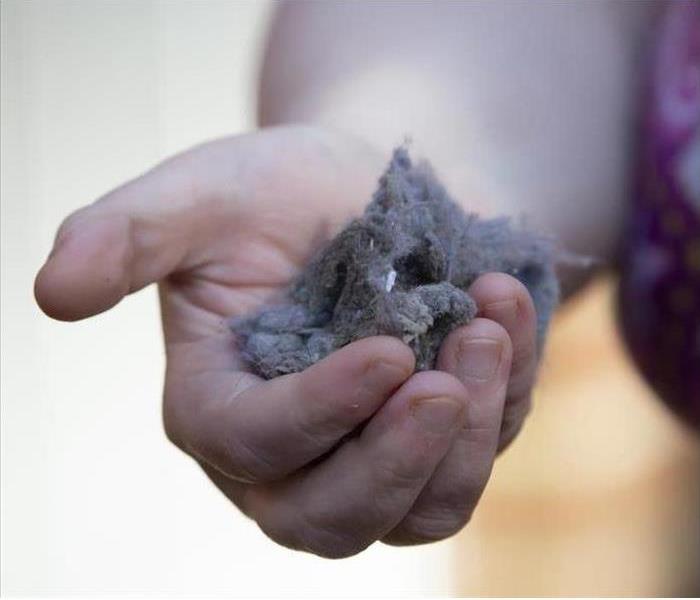 Prevent lint fires.
Prevent lint fires.
When dryer lint accumulates in the dryer and vents, the risk of a lint fire increases, in addition to decreasing the efficiency of the appliance. Fortunately, you can extend the length of the dryer, increase its efficiency, and protect against a dryer fire with three basic chores.
3 Chores to Prevent a Lint Fire
- Clean the Lint Screen Each Time You Run the Dryer
Before you put laundry in the dryer, pull out the lint screen and remove the fibers and debris caught there. If necessary, use a soft brush attachment to complete this step. From time to time, it's important to rinse the lint screen with water and a little bit of dish soap. This is particularly important if you use dryer sheets because a residue may accumulate on the screen. As a final step in this task, remove any lint inside the trap with your hand or a narrow vacuum attachment.
- Brush Out the Hoses and Vent
Cleaning out the vents behind your dryer is one of the most important steps in preventing a lint fire and the resulting fire damage. Start by unplugging your dryer and disconnecting the exhaust hose at both ends. If your dryer is an older model or is connected to gas, contact a professional to avoid gas leaks. Next, use a cleaning brush or special vacuum attachment to remove lint and other debris from the hose. A vent cleaning kit may be required to remove accumulated debris from the vent that extends from your laundry room to the exterior of your home.
- Open the Dryer and Remove Lint
Every six months (and more often if the dryer is used heavily,) remove the access panel, usually located at the back of the appliance. Remove any lint or debris and wipe off any areas with visible dust. Handle the heating element and wiring gently to avoid causing damage. Finally, replace the panel.
These steps can protect your appliance and home from a lint fire and the need for repairs from a Ogden, UT, cleanup and restoration team. How long has it been since you cleaned your vents?
5 Flood Prevention Strategies To Know
7/18/2022 (Permalink)
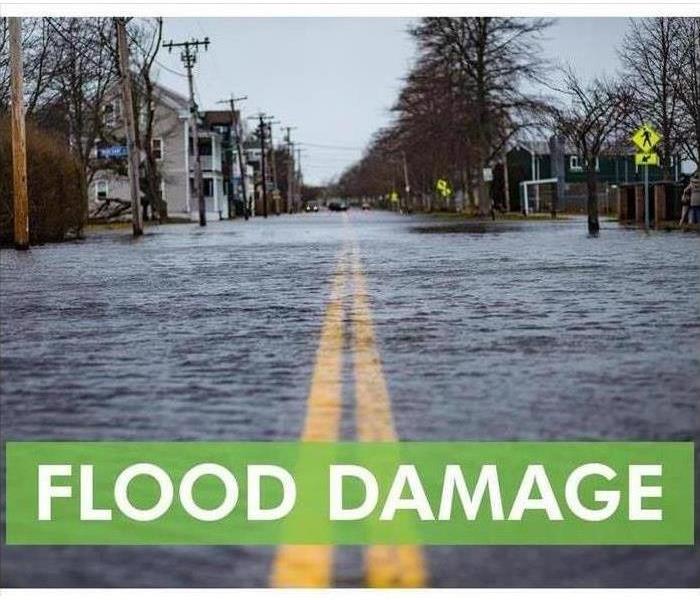 Flood damage can be devastating without a prevention plan.
Flood damage can be devastating without a prevention plan.
For business in Ogden, UT, flood prevention steps may be important when storm season arrives. Many storm damage restoration professionals have recommended tips that may mitigate damage. Here are a few things to consider when preparing your company property against flooding.
Flood Prevention Steps
Believe it or not your landscaping choices may be able to help when it comes to flood mitigation. Slope landscaping away from the building's foundation, and choose local or deep-rooted plants to soak up extra moisture.
If your business is located in an area known for high water during storms, you may want to consider the installation of a retaining wall. A wall or similar installation can help prevent water from flowing into areas where it could pool or cause flooding.
Another tip for flood prevention is to ensure that all your drainage areas are properly covered. This can help keep debris out of the chute which can lead to clogs and other water backup problems.
Regular maintenance of your business property may help mitigate any flood cleaning needed after a large storm. You may want to check areas such as your roof or basement, and ensure that any drainage systems are clear of debris. If you do find an issue it's important to take care of any necessary repairs as quickly as possible.
You may also find it helps to stay informed of the weather patterns in your area. This way you will know ahead of time when a storm is approaching, and be able to take the necessary prevention measures.
When creating your flood prevention plan for your business, consider the use of landscaping, retaining walls, and drainage covers preventing the pooling of flood water on your land. Performing regular maintenance of your company building can also prevent additional damage when the storm hits. It may also help to stay informed of the weather in your area.
3 Steps To Take To Fix a Flooded Basement
7/18/2022 (Permalink)
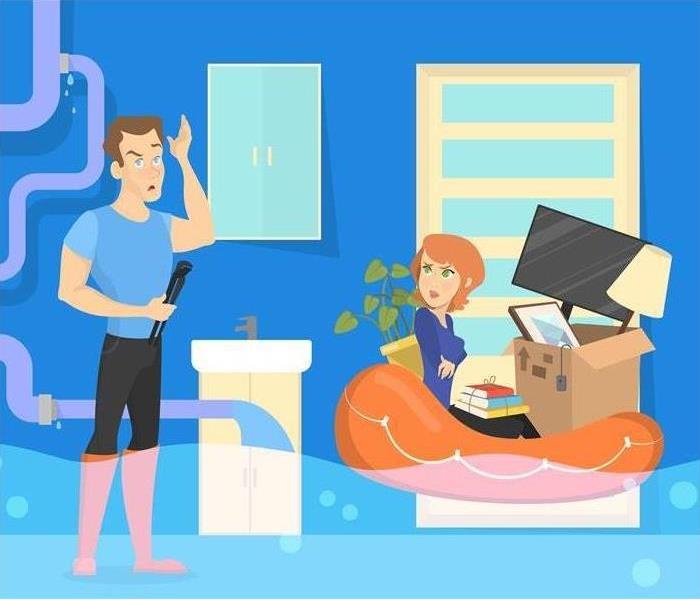 Fix your flooded basement and avoid further damage.
Fix your flooded basement and avoid further damage.
Because of its location, your basement is likely to be the first part of your home to fill with water during a severe flood. A basement flood can cause damage to your foundation, electrical system and any property located in the basement. It can also be an electrocution hazard. These are three steps you can take to fix your flooded basement.
Steps to Fix Your Flooded Basement
- Turn Off the Power
Standing water can become electrified if it comes in contact with a power source, so before you do anything else you should make sure the power to your home is shut off. If the water in your basement is shallow, you can use dry lumber, a step stool or a ladder to get above the water level and shut off the power at your service panel. Wear rubber boots and gloves to protect yourself. If the water is above the level of any electrical outlets or you can't get to your service panel, call the power company in Ogden, UT, and ask them to disconnect your house from the power grid.
- Remove the Water
You can use a wet-dry vac or a mop and bucket to remove the water from a minor basement flood. However, you will need to contact the fire department or rent a heavy-duty gas-engine pump to drain a severely flooded basement. Alternatively, you can contact a water remediation company to assist you.
- File an Insurance Claim
If you have flood insurance, your insurance coverage may pay for the cost to drain and dry out your basement and replace any damaged property. Contact your insurance agent or claims department as soon as possible to get your claim started.
A basement flood in your home can be a major hassle and a safety concern. Taking the proper steps to fix your flooded basement can reduce your potential property damages and protect your family.
How To Clean Your Backyard Grill and Prevent a Grease Fire
6/22/2022 (Permalink)
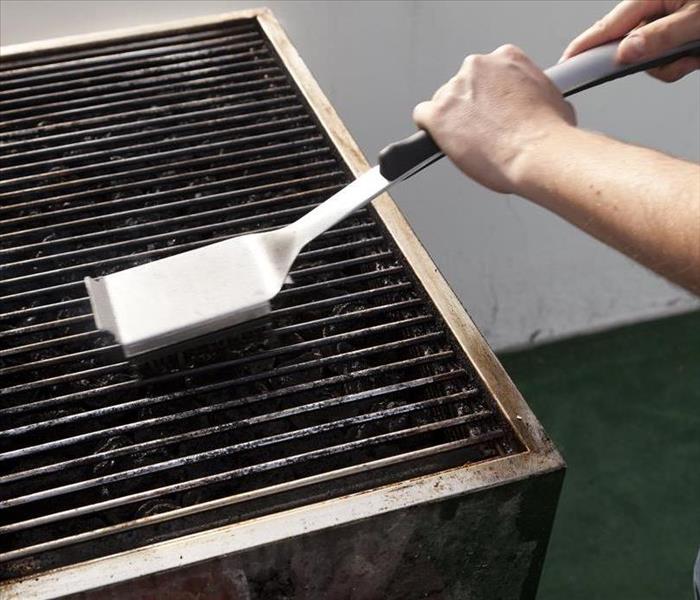 Cleaning Your Backyard Grill can also prevent Fire Damage.
Cleaning Your Backyard Grill can also prevent Fire Damage.
Proper grill maintenance is important for several reasons. Excess smoke and grease residue could change the flavors of your grilled meats and vegetables. The debris may also prevent the grill from getting as hot as you need it to be. A dirty grill could additionally spark a grease fire that spreads to your Ogden, UT, home. To avoid the need for fire damage restoration services, keep your grill clean by following the below suggestions.
Grill Cleaning Tips
To prevent leaves and other falling debris from landing on your grill, you should protect it with a cover whenever it is not in use. When you are ready to clean, turn on the grill briefly. The process works best when the grill is warm. Before you start cleaning, wait for the grill to cool down so you will not get burned.
While these basic tips apply to most grills, the cleaning process is not the same for every grill. There are several different types of grills, each of which should get cleaned differently:
- Pellet Grills
- Gas Grills
- Charcoal Grills
Cleaning Pellet Grills
A pellet smoker is fairly easy to clean. Start by removing the grates and soaking them in soapy, warm water. Then use a wet-dry vacuum to remove any debris that is inside the grill. Next, take a brush and scrub the drip pan and the inside of the chimney. Finish by wiping the entire grill with a damp cloth.
Cleaning Gas Grills
You should thoroughly clean your gas grill at the start and end of each grilling season. After preheating the grill for 15 minutes and turning off the gas, remove debris with a wet wire brush. Add a grill cleaning solution or regular soap for stuck-on grease.
You should also use the wire brush and water to clean the inside sections of the grill. When you are finished using the grill brush, wipe down the areas that you have just cleaned. This should remove any bristles that dislodged from the brush.
Grease can also block the gas ports of the grill. Remove the burners and use a dry brush to eliminate any clogs in the ports. Move the brush sideways so you do not accidentally force debris deeper into the ports. For the outside of the grill, check your instruction manual.
You can probably use regular soap and water to clean porcelain, painted steel and ceramic grills. However, stainless-steel grills require microfiber cloths and specialized cleaners.
Cleaning Charcoal Grills
Charcoal grills should be cleaned quite frequently. That is because ash from the charcoal settles at the bottom of the grill with every use. Over time, this ash could clog the grill vents.
Use either a stiff-wire brush or a wad of aluminum foil to clean the grates of your charcoal grill. Then put vegetable oil on a towel or rag and rub it on the clean grates. This should limit future buildups. Finally, put dish soap on a steel brush and scrub the inside of the grill bowl.
Grill cleaning may seem like an annoying process. Yet taking the time to wash your barbecue at the start and end of the summer should reduce the chances of a grease fire and improve the taste of your meat.
Water Mitigation Procedures for a Leaking Water Heater
6/17/2022 (Permalink)
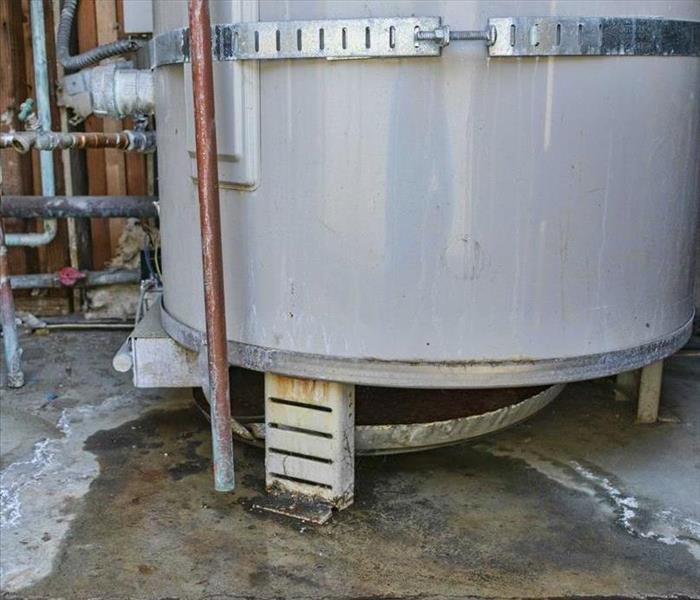 Learn More about the Water Mitigation Procedures with Our Professionals.
Learn More about the Water Mitigation Procedures with Our Professionals.
Homeowners often take their water heaters for granted until they stop working correctly. You may never think about how hard your appliance works each day to provide you with the essential hot water for taking showers, cleaning dishes, and washing clothes.
Unfortunately, sometimes there is nothing you can do to prevent a leaking water heater, but there are steps for mitigating the damage if it happens.
Steps To Take After a Failed Water Heater
1. Turn Off All Utilities
When you're experiencing a leak, it's best to shut off your water supply until you find the source of the leak and fix it. You can shut off your water at either your home's main valve or the valve that leads directly to the water heater. You should see two valves (i.e., for hot and cold water) beside the water heater.
If you have a gas-powered water heater, shut off your home's gas supply. Then, turn off the power to your home or the breaker for the water heater. Now, you can safely look for the leak and repair it.
2. Drain the Water Heater
If you have more than a tiny leak, it may be best to drain the water heater. Draining it will ensure that an influx of water doesn't occur, which could cause more damage to your home and contents. Draining the water heater is a simple procedure; connect a hose to the drain valve. This valve is located at the bottom of the appliance. The hose should allow the water to travel outdoors. Gravity will do the work of draining it once you loosen the drain valve.
3. Look for the Leak
There are several places from which your water heater may be leaking. Most of the time, water from a leaking water heater originates from the bottom of the appliance. Therefore, you may want to inspect that part first.
4. Remove All the Standing Water
Hopefully, you have a drain pan there to catch a leak and avoid water damage. However, if you discover standing water, it's essential to extract it as soon as possible. The easiest way to do this is to use a wet/dry vacuum. If the water has been sitting for a while, you may need to call water damage restoration professionals to inspect and repair the damage.
5. Remove the Excess Moisture
Next, it's time to remove the excess humidity from the air. Using a humidifier tends to work the best for this. You can also use heaters, fans and fresh air. If you see mold, avoid anything that will cause air to blow, as it can spread mold spores.
6. Inspect for Water Damage
Homes can sustain damage quickly with excess moisture, especially standing water. It's critical to inspect the entire area before and after cleaning and restoration.
If you discover that you have a leaking water heater in Ogden, UT, you will need to find the source and repair it as soon as possible. You'll also need to clean up the water immediately after stopping the leak. You can often prevent a broken water heater by regularly maintaining it.
Understanding the Sewer Cleanup Process
6/13/2022 (Permalink)
 The professionals can help you with the Sewer Cleanup Process.
The professionals can help you with the Sewer Cleanup Process.
When a toilet overflows or the sewer backs up, professional mitigation is necessary to ensure that the problem is fully resolved. You can be confident recommending SERVPRO to your residential clients in Ogden, UT, whenever sewer cleanup is needed. Each local franchise is backed by corporate resources and support.
The Steps of the Sewer Backup Mitigation Process
Within hours of the initial contact, the sewer damage remediation team arrives at the house to start the cleanup process. SERVPRO has a reputation for being Faster to Any Size Disaster and handles each job in an efficient manner.
Assessment
The first thing technicians have to do is survey the sewer damage and create a workable plan. There are several outcomes customers can expect from the assessment stage:
- Itemized list of damages
- Repairs needed to restore home
- Estimated overall cost
- Verbal briefing with homeowners
If there is too much damage for the local specialists to handle quickly, they can call nearby SERVPRO teams for backup. The extra technicians are certified to provide the same quality of service.
Extraction
Sewer backup leaves a lot of contaminated water in its path. Before the home can be cleaned, the crew has to remove as much of the excess moisture and debris as possible. Industrial pumps make this process go more smoothly.
Removal
Every item that is touched by the dirty water has to be taken out of the home. Some of the customers' belongings can probably be cleaned, but delicate items may have to be replaced altogether. During the early stages of the sewer cleanup process, drywall, ceiling materials, tiles, carpet and insulation that have become contaminated must be torn out.
Sanitation
Every surface that remains after all ruined materials are torn out must be disinfected. Water from a flooded toilet is typically contaminated, leaving behind all sorts of bacteria and other microbes on anything it touches. The mitigation team cleans the area and then tests each surface to make sure that any microorganism that isn't supposed to be there is gone.
Drying
Sewage can leave behind excess moisture. To prevent secondary damage such as rot or mold growth, the area must be dried thoroughly. Technicians can increase airflow in the space to speed up the process. They also may bring in dehumidifiers to ensure that the moisture in the air is brought back to an acceptable level.
Rebuilding
SERVPRO staff members don't just gut the house and leave. They replace the materials they had to tear out. Each item that can be salvaged is repaired and returned to the owner. The technicians even go so far as to match paint and tile to the remaining surfaces for a seamless flow. Their job isn't finished until the home looks "Like it never even happened."
The sewer cleanup process can seem daunting at first, but hiring an experienced, knowledgeable team ensures that it is as simple as possible for the homeowners. With the fast, efficient response of a local team and corporate support, it's no wonder that SERVPRO is a preferred vendor for many insurance providers throughout the country.




 24/7 Emergency Service
24/7 Emergency Service









